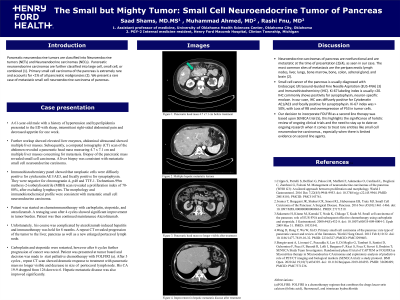Monday Poster Session
Category: Biliary/Pancreas
P1910 - The Small but Mighty Tumor: Small Cell Neuroendocrine Carcinoma of Pancreas
Monday, October 28, 2024
10:30 AM - 4:00 PM ET
Location: Exhibit Hall E

Has Audio

Muhammad Ahmed, MD
Henry Ford Macomb Hospital
Clinton Township, MI
Presenting Author(s)
Saad Shams, MD, Muhammad Ahmed, MD, Rashi Fnu, MD
Henry Ford Macomb Hospital, Clinton Township, MI
Introduction: Pancreatic neuroendocrine tumors are classified into two major types: Neuroendocrine tumors (NETs) and Neuroendocrine carcinomas (NECs). Pancreatic neuroendocrine carcinomas are further classified into either large cells or small cells (1). Primary pancreatic small cell carcinoma is extremely rare and accounts for less than 1% of all pancreatic malignancies (2).
Case Description/Methods: A 61-year-old male with a history of hypertension and hyperlipidemia presented to the ED with sharp, intermittent right-sided abdominal pain and decreased appetite for one week. During a recent routine annual visit, the patient was also found to have elevated transaminases. An abdominal ultrasound showed multiple liver masses. Subsequently, a computed tomography (CT) scan of the abdomen revealed a pancreatic head mass measuring 6x3 cm and multiple liver masses concerning for metastasis. Biopsy of the pancreatic mass revealed small cell carcinoma. A liver biopsy was consistent with metastatic small cell neuroendocrine carcinoma. The patient started chemoimmunotherapy with carboplatin, etoposide, and atezolizumab. A restaging scan after 2 cycles showed significant improvement in tumor burden. High dose steroids were initiated because atezolizumab maintenance therapy resulted in hepatitis and the patient was off immunotherapy for 9 months due to intolerance. A repeat CT revealed progression of the tumor along with newly enlarged portocaval lymph nodes. Carboplatin and etoposide were restarted. During a recent visit with oncology, there was ongoing discussion regarding the patient’s enrollment in CAPTEM versus FOLFIRI clinical trial as second-line therapy.
Discussion: Neuroendocrine carcinomas of pancreas are nonfunctional and are metastatic at the time of presentation (2)(4), as seen in our case. The most common sites of metastasis are the peripancreatic lymph nodes, liver, lungs, bone marrow, bone, colon, adrenal gland, and brain (2).
Small cell cancer of the pancreas is usually diagnosed with Endoscopic Ultrasound-Guided Fine Needle Aspiration (EUS-FNA) (3) and Immunohistochemistry (IHC). Ki-67 labeling index is usually >20. IHC commonly shows positivity for synaptophysin, neuron-specific enolase. In our case, IHC was diffusely positive for AE1/AE3 and focally positive for synaptophysin. Ki-67 index was > 50%, Loss of RB, and overexpression of P53 in tumor cells. Pancreatic NECs are extremely rare and treatment should be established by a multidisciplinary team, while closely monitoring for side effects.
Disclosures:
Saad Shams, MD, Muhammad Ahmed, MD, Rashi Fnu, MD. P1910 - The Small but Mighty Tumor: Small Cell Neuroendocrine Carcinoma of Pancreas, ACG 2024 Annual Scientific Meeting Abstracts. Philadelphia, PA: American College of Gastroenterology.
Henry Ford Macomb Hospital, Clinton Township, MI
Introduction: Pancreatic neuroendocrine tumors are classified into two major types: Neuroendocrine tumors (NETs) and Neuroendocrine carcinomas (NECs). Pancreatic neuroendocrine carcinomas are further classified into either large cells or small cells (1). Primary pancreatic small cell carcinoma is extremely rare and accounts for less than 1% of all pancreatic malignancies (2).
Case Description/Methods: A 61-year-old male with a history of hypertension and hyperlipidemia presented to the ED with sharp, intermittent right-sided abdominal pain and decreased appetite for one week. During a recent routine annual visit, the patient was also found to have elevated transaminases. An abdominal ultrasound showed multiple liver masses. Subsequently, a computed tomography (CT) scan of the abdomen revealed a pancreatic head mass measuring 6x3 cm and multiple liver masses concerning for metastasis. Biopsy of the pancreatic mass revealed small cell carcinoma. A liver biopsy was consistent with metastatic small cell neuroendocrine carcinoma. The patient started chemoimmunotherapy with carboplatin, etoposide, and atezolizumab. A restaging scan after 2 cycles showed significant improvement in tumor burden. High dose steroids were initiated because atezolizumab maintenance therapy resulted in hepatitis and the patient was off immunotherapy for 9 months due to intolerance. A repeat CT revealed progression of the tumor along with newly enlarged portocaval lymph nodes. Carboplatin and etoposide were restarted. During a recent visit with oncology, there was ongoing discussion regarding the patient’s enrollment in CAPTEM versus FOLFIRI clinical trial as second-line therapy.
Discussion: Neuroendocrine carcinomas of pancreas are nonfunctional and are metastatic at the time of presentation (2)(4), as seen in our case. The most common sites of metastasis are the peripancreatic lymph nodes, liver, lungs, bone marrow, bone, colon, adrenal gland, and brain (2).
Small cell cancer of the pancreas is usually diagnosed with Endoscopic Ultrasound-Guided Fine Needle Aspiration (EUS-FNA) (3) and Immunohistochemistry (IHC). Ki-67 labeling index is usually >20. IHC commonly shows positivity for synaptophysin, neuron-specific enolase. In our case, IHC was diffusely positive for AE1/AE3 and focally positive for synaptophysin. Ki-67 index was > 50%, Loss of RB, and overexpression of P53 in tumor cells. Pancreatic NECs are extremely rare and treatment should be established by a multidisciplinary team, while closely monitoring for side effects.
Disclosures:
Saad Shams indicated no relevant financial relationships.
Muhammad Ahmed indicated no relevant financial relationships.
Rashi Fnu indicated no relevant financial relationships.
Saad Shams, MD, Muhammad Ahmed, MD, Rashi Fnu, MD. P1910 - The Small but Mighty Tumor: Small Cell Neuroendocrine Carcinoma of Pancreas, ACG 2024 Annual Scientific Meeting Abstracts. Philadelphia, PA: American College of Gastroenterology.

